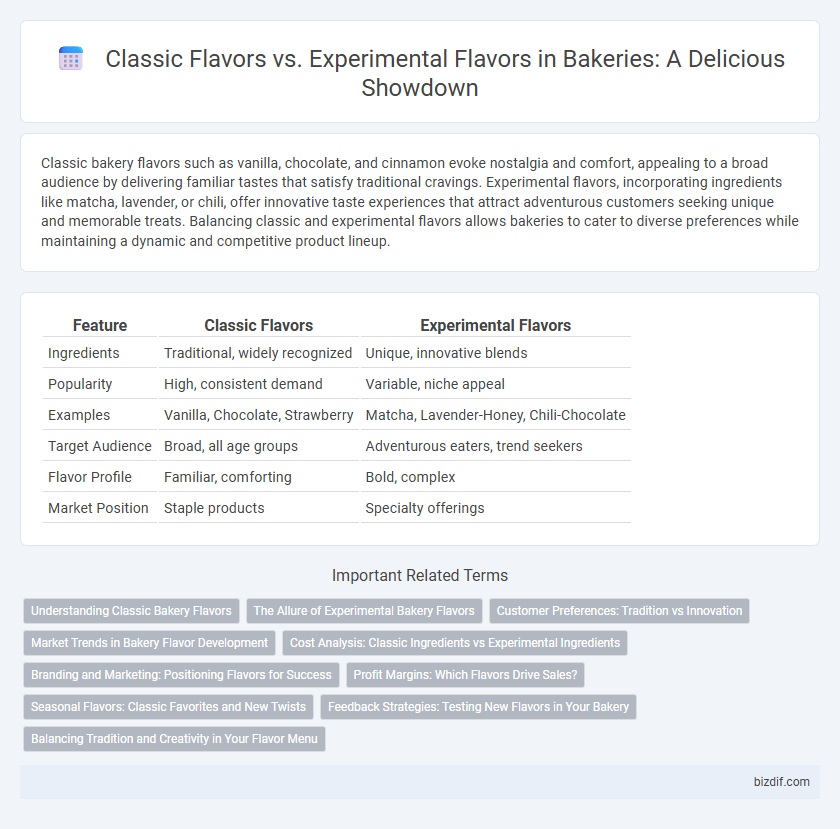Classic bakery flavors such as vanilla, chocolate, and cinnamon evoke nostalgia and comfort, appealing to a broad audience by delivering familiar tastes that satisfy traditional cravings. Experimental flavors, incorporating ingredients like matcha, lavender, or chili, offer innovative taste experiences that attract adventurous customers seeking unique and memorable treats. Balancing classic and experimental flavors allows bakeries to cater to diverse preferences while maintaining a dynamic and competitive product lineup.
Table of Comparison
| Feature | Classic Flavors | Experimental Flavors |
|---|---|---|
| Ingredients | Traditional, widely recognized | Unique, innovative blends |
| Popularity | High, consistent demand | Variable, niche appeal |
| Examples | Vanilla, Chocolate, Strawberry | Matcha, Lavender-Honey, Chili-Chocolate |
| Target Audience | Broad, all age groups | Adventurous eaters, trend seekers |
| Flavor Profile | Familiar, comforting | Bold, complex |
| Market Position | Staple products | Specialty offerings |
Understanding Classic Bakery Flavors
Classic bakery flavors such as vanilla, chocolate, and cinnamon form the foundation of traditional baked goods, offering familiar and comforting tastes that appeal to a wide audience. These flavors are often derived from time-tested recipes and high-quality ingredients, ensuring consistent texture, aroma, and overall satisfaction. Mastery of classic bakery flavors is essential for creating balanced products that serve as a reliable base for innovation in experimental flavor combinations.
The Allure of Experimental Bakery Flavors
Experimental bakery flavors captivate consumers by offering unique taste experiences that transcend traditional profiles such as vanilla, chocolate, and cinnamon. Infusions of ingredients like lavender, matcha, or spicy chili create novel combinations that intrigue adventurous food enthusiasts and drive trend innovations in artisan bakeries. This fusion of unexpected flavors supports brand differentiation and encourages repeat visits from customers seeking new sensory delights.
Customer Preferences: Tradition vs Innovation
Customers who favor classic flavors often seek comfort and nostalgia, gravitating towards time-tested recipes like vanilla, chocolate, and cinnamon that evoke familiar, satisfying experiences. Conversely, those drawn to experimental flavors prefer innovative combinations such as matcha-lavender or chili-chocolate, craving novelty and unique taste adventures that challenge traditional palates. Understanding this spectrum of preferences enables bakeries to strategically balance their menu offerings, appealing simultaneously to patrons who cherish tradition and those who pursue culinary creativity.
Market Trends in Bakery Flavor Development
Classic bakery flavors such as vanilla, chocolate, and cinnamon continue to dominate consumer preferences due to their familiarity and widespread appeal. Experimental flavors, including exotic spices, floral notes, and fusion ingredients, are gaining traction as artisanal bakeries seek to differentiate themselves in a competitive market. Current market trends indicate a growing demand for innovative flavor profiles driven by younger demographics and social media influence, which encourages bakeries to blend tradition with bold experimentation.
Cost Analysis: Classic Ingredients vs Experimental Ingredients
Classic flavors in bakery typically rely on staple ingredients like flour, sugar, eggs, and butter, which are widely available and cost-effective due to mass production and supply chain stability. Experimental flavors often require specialty ingredients such as exotic spices, rare fruits, or imported flavorings that significantly increase ingredient costs and complicate inventory management. Cost analysis reveals that while classic flavors maximize profit margins through low-cost raw materials, experimental flavors demand higher upfront investment but can justify premium pricing and attract niche markets.
Branding and Marketing: Positioning Flavors for Success
Classic flavors like vanilla and chocolate provide a reliable foundation for bakery branding, appealing to broad consumer preferences and establishing trust through familiarity. Experimental flavors, such as lavender-honey or matcha-rose, differentiate brands by targeting niche markets and creating unique storylines that enhance marketing campaigns. Effective positioning combines the proven appeal of classic tastes with the intrigue of innovative flavors to maximize customer engagement and brand loyalty.
Profit Margins: Which Flavors Drive Sales?
Classic bakery flavors such as vanilla, chocolate, and cinnamon consistently generate higher profit margins due to their widespread customer appeal and reliable sales volume. Experimental flavors often yield lower initial profit margins but can attract niche markets and create buzz, leading to increased brand recognition and potential long-term revenue growth. Analyzing sales data reveals that balancing classic and experimental flavors maximizes overall profitability by catering to both steady demand and adventurous consumer trends.
Seasonal Flavors: Classic Favorites and New Twists
Seasonal flavors in bakery offer classic favorites like pumpkin spice, cinnamon apple, and peppermint that evoke traditional comfort and nostalgia. Contemporary bakeries experiment with new twists by incorporating unique ingredients such as lavender honey, matcha, and blood orange to create innovative seasonal treats. Balancing classic and experimental flavors appeals to a wide range of customers seeking both familiar tastes and adventurous new experiences.
Feedback Strategies: Testing New Flavors in Your Bakery
Implementing structured feedback strategies, such as customer surveys and in-store tastings, provides invaluable insights when testing both classic and experimental flavors in your bakery. Monitoring sales data alongside qualitative feedback helps identify which flavors resonate most with your clientele, enabling data-driven decisions to optimize your product lineup. Encouraging direct customer interaction through social media polls or loyalty programs further refines flavor offerings while building brand engagement.
Balancing Tradition and Creativity in Your Flavor Menu
Classic flavors like vanilla, chocolate, and cinnamon provide a trusted foundation that appeals to a broad customer base seeking familiar tastes. Experimental flavors such as lavender-honey, matcha, and spicy chili add innovative twists that attract adventurous eaters and differentiate your bakery in a competitive market. Balancing tradition and creativity ensures a diverse flavor menu that honors timeless favorites while embracing unique combinations to enhance customer satisfaction and loyalty.
Classic Flavors vs Experimental Flavors Infographic

 bizdif.com
bizdif.com